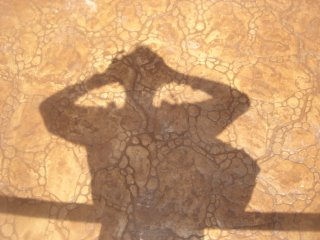
United States architect, Eugene Tsui, has designed the longest bridge in the world spanning the Strait of Gibraltar and connecting the continents of Europe and Africa. This revolutionary design does not resemble any existing bridge and features an original floating and submerging concept while creating a three mile wide floating island in the middle of the Mediterranean Sea. From this newly created island a person could view both the European and African continents for the first time in human history. When construction begins it would be the biggest architectural project in the world—and the most ecological—dwarfing Three Gorges Dam in China and Ground Zero in New York City-- and would instantly become the greatest tourist destination on Earth. Spanning about 9 miles the 14.5 kilometer floating bridge contains 150 windmills and 80 underwater tidal turbines generating 12 billion kilowatt hours of electricity. Windmills and turbines can be easily added to the design as needed.
The bridge can generate enough electricity to power the southern Spanish province of Cadiz and the entire nation of Morocco making it the largest wind and water power farm in the world. This feature allows the bridge to pay for itself many times over in electrical generation not to mention tourist dollars. This is the first truly viable design in a long history of attempting to connect both continents. The design utilizes the natural current flow of the Strait and its constant winds and does not disturb the existing ecology and marine life of the site. Cost to build the bridge is ten billion U.S. dollars and would be a joint governmental partnership between Morocco, France and Spain.
The bridge is designed to float gracefully on and under the water like a giant, elegant serpent anchored to the cities of Tarifa on the southern coast of Spain to Point Cires on the northern tip of Morocco. The first mile of the bridge extends out from the coast line and then gradually slopes under the Mediterranean for two miles at a maximum depth of 200 meters or 658 feet. The bridge then slopes upward to a center floating island of three miles in length and continues down underwater again to slope up and come out onto the neighboring continent. The design allows very large ships to pass unimpeded within a four mile width where the bridge is submerged and leaves marine currents undisturbed.
Eugene Tsui’s Strait of Gibraltar Floating Bridge, as a tourist attraction, would potentially double Spain’s 50 million annual tourists and significantly increase Morocco’s current 2.3 million annual tourists to a whopping 60 million, a potential increase of 2600% or 26 times the current annual influx. This amounts to over 8 billion U.S. dollars to each country annually not to mention the significant increase in tourism to both continents. In other words, Tsui’s bridge design has the potential to jump start the entire economy of north Africa and possibly the entire African continent in one project. No doubt it would be the Eighth Wonder Of The World.
What about traffic congestion for the 60 or more million travelers who will cross the bridge? There are 24 lanes total for motor vehicle traffic; 8 lanes for automobile traffic in each direction and 4 lanes for trucks and buses. 4 standard train tracks and 2 high speed trains complete the motor vehicle accommodations. In addition, 5 elevated 30 meter wide pedestrian lanes accommodate people who wish to walk, bicycle, ride camels and horses. Lush gardens, trees, flowers, waterfalls, rest areas and drinking fountains surround all pedestrian areas which are raised one meter above motor vehicle lanes for safety. The bridge is designed to be an experience and destination in itself with an estimated 150,000 to 300,000 traveling daily and 500,000 persons at peak seasons and special days of the year.
At the three mile wide center of the bridge is a floating island which contains 150 windmills, the world’s largest enclosed convention and exhibition area 2 kilometers long (a little over a mile long), 140 meters high, 250 meters wide with 23 floors at 20 meter ceiling height with 500,000 meters squared on each floor and 1 million square meters of total parking space. The island is a veritable city flanked by 120 meter high light houses, outdoor performance plazas, theatres, giant outdoor bazaars and food markets, rolling hills of grass, flowers, trees, parks, water lagoons, bays, 50 meter high waterfalls and fountains, drinking and feeding troughs for animals, bathrooms, giant tented markets and kiosks, two large marinas for boats and tourist ships, photovoltaic solar electricity farms, constructed wetlands for raw sewage and grey water and ecological desalination plants. Similar accommodations are located at the bridge ends as it joins Tarifa and Point Cires.
The bridge is made of waterproof concrete, electrolytic concrete, stainless steel and anodized aluminum. Air passes rapidly through the underwater sections through a phenomenon called the Venturi effect where higher air is attracted to closed spaces and accelerates through these spaces to create a natural airflow and constant exchange of air with no mechanical power needed. All along the bridge are many areas for rest, music and dance performances, kiosks and open market bazaars. Flowers, trees, pools and waterfalls separate pedestrians from motor vehicles. It is a true extension of both African and European cultures come together on a road 14.5 kilometers long (9 miles) in the middle of the Mediterranean Sea. A spectacular setting with the smells, sights and sounds of European and African cultures stir the imagination.

3 comments:
Dude, that sounds awesome. Maybe it's a good time to change to Civil...
no more changing majors for you buddy
cohedralinvestments.com. claims 2 have intellectual patent 4 bridge technology along with 11 other IPO's 2 b launched in 90 days. Is this possible or just another investment scam?
Post a Comment